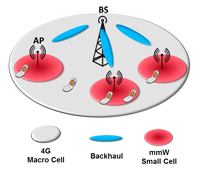 CEA-Leti announced that a consortium of 15 leading telecommunications operators, vendors, research centers and academic institutions have launched “MiWaveS” (Millimeter-Wave Small Cell Access and Backhauling), a European collaborative project whose goal is to develop millimeter-wave (mmW) key radio technologies to provide multi-Gbps data rates to future fifth generation (5G) cellular mobile networks users.
CEA-Leti announced that a consortium of 15 leading telecommunications operators, vendors, research centers and academic institutions have launched “MiWaveS” (Millimeter-Wave Small Cell Access and Backhauling), a European collaborative project whose goal is to develop millimeter-wave (mmW) key radio technologies to provide multi-Gbps data rates to future fifth generation (5G) cellular mobile networks users.
The global mobile data traffic is expected to increase by orders of magnitude in the next decade, driven by video streaming, web services, cloud computing and machine-to-machine applications. Data rates provided to mobile users are also expected to increase accordingly. The evolution of mobile networks towards these objectives is impeded by major bottlenecks, such as the scarcity of spectrum resources below 6 GHz leading to high interference levels, the public concern about microwave electromagnetic field (EMF) exposure in dense areas, the power consumption of the infrastructure, and the flexibility and robustness of the network.
Dr. Laurent Dussopt, MiWaveS project manager and Leti research engineer, explains that “the flexible spectrum usage of the mmW frequency bands at 60 GHz and 71 to 86 GHz will enable data transmissions up to 10 Gbps for backhaul and 5 Gbps for mobile users access.” He also indicates that “MiWaveS’ objectives lead to significant challenges on the system architecture, networking functions and algorithms, radio and antenna technologies.”
MiWaveS is expected to have a major impact on the key enabling technologies for the next generation of heterogeneous wireless networks. The deployment of mmW small cells in dense urban areas will not only improve the flexibility of the access infrastructure, but also the spectral and energy efficiency by low-power access points using mmW spectrum resources.
The MiWaveS project is partially funded by the European Commission's Seventh Framework Program.
(FP7), within the Work Programme for Information and Communication Technologies under the objective “Network of the Future.” This objective supports the development of future network infrastructures that allow the convergence and interoperability of heterogeneous mobile, wired and wireless broadband network technologies as enablers of the future Internet.
The MiWaveS consortium relies on the diverse and complementary expertise of its members: CEA-Leti (FR), Telecom Italia (IT), Orange (FR), Nokia (FI), Intel Mobile Communications (DE), National Instruments Dresden (DE), STMicroelectronics (FR, IT), Sivers IMA (SE), Optiprint (CH), VTT (FI), Tech. Univ. Dresden (DE), Tecnologias Servicios Telematicos y Systemas (ES), Univ. of Rennes 1 (FR), Univ. of Surrey (UK).
The MiWaveS project was launched at the beginning of January 2014, and will last for three years. Visit the project website at http://www.miwaves.eu
